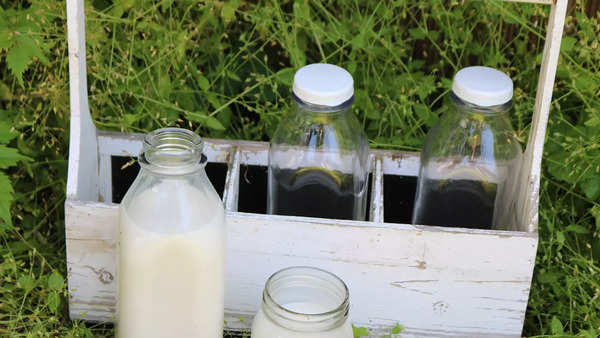According to a new Stanford study, influenza or flu virus remains infectious in
refrigerated raw milk
for up to five days.
The findings come at a time when outbreaks of bird flu – a different subtype of the same influenza virus – in dairy cattle have raised concerns about the potential for a new pandemic.
What does the study say?
According to the new Stanford University study, raw milk which is hailed by some as a natural and nutritious alternative to pasteurized dairy, may come with some hidden dangers. The recently published research on ‘Environmental Science & Technology Letters’ reveals that influenza or flu virus can remain infectious in refrigerated raw milk for up to five days.
Study senior author Alexandria Boehm, the Richard and Rhoda Goldman Professor of Environmental Studies in the Stanford Doerr School of Sustainability and the Stanford School of Engineering, “This work highlights the potential risk of
avian influenza transmission
through consumption of raw milk and the importance of milk pasteurization.”
The Food and Drug Administration has tied raw milk to over 200 outbreaks of illnesses, and – together with the Centers for Disease Control and Prevention (CDC) – warns that germs, such E. coli and Salmonella, in raw milk present “serious” health risks, especially for children, the elderly, pregnant women, and people with weakened immune systems.
What is highly pathogenic avian influenza?
Highly pathogenic avian influenza, or HPAI, is a type of bird flu that causes a severe, and often fatal, illness in birds. Like other influenza A viruses, bird flu is characterized by two proteins found on its surface: hemagglutinin (HA) and neuraminidase (NA). In birds, there are 16 different types of HA and nine different types of NA.
HPAI viruses have one of two HA types, 5 or 7, and are called H5 and H7 viruses. While many H5 and H7 viruses are low pathogenic (LPAI), meaning they cause milder illness, viruses like H5N1, H5N8, and H7N9 are all HPAI.
H5N1 is the HPAI virus that was found in dairy cows.
Can raw milk cause the avian influenza?
More than 14 million Americans consume raw milk annually. Unlike pasteurized milk, raw milk is not heated to kill potentially harmful pathogens. Proponents of raw milk claim that it leaves more beneficial nutrients, enzymes, and probiotics than in pasteurized milk, and can boost immune and gastrointestinal health.
The researchers from Stanford University explored the persistence of a strain of human influenza virus in raw cow’s milk at typical refrigeration temperatures. The flu virus, called H1N1 PR8, survived and remained infectious in the milk for up to five days.
Study co-lead author Mengyang Zhang, a postdoctoral scholar in civil and environmental engineering, said, “The persistence of infectious influenza virus in raw milk for days raises concerns about potential transmission pathways. The virus could contaminate surfaces and other environmental materials within dairy facilities, posing risks to animals and humans.”
The researchers also found that flu virus RNA – molecules that carry genetic information but are not considered a health risk – remained detectable in the raw milk for at least 57 days. Although exposure to influenza virus RNA does not pose a health risk, RNA-based testing methods are often used to conduct environmental surveillance of pathogens like influenza.
As per study co-lead author Alessandro Zulli, a postdoctoral scholar in civil and environmental engineering, “The prolonged persistence of viral RNA in both raw and pasteurized milk has implications for food safety assessments and environmental surveillance, particularly because many of the techniques used in environmental surveillance detect RNA.”
What’s the solution?
Rather than raw milk, it is advisable to consume pasteurized milk, which is milk that has been heated to a specific temperature for a set amount of time to kill harmful bacteria. Pasteurization is the simple and brief heating of foods and liquids to kill off microbes that can cause spoilage or food poisoning. Unsurprisingly, extensive research has shown that unpasteurized, or raw, dairy products can spread harmful germs. A 2018 study, for instance, found that raw milk and cheese products accounted for 96% of all reported foodborne illnesses traced back to dairy over a five-year span. Moreover, pasteurization completely destroyed infectious influenza in the milk and reduced the amount of viral RNA by almost 90%; however, it didn’t eliminate the RNA entirely.
I’m Manas Ranjan Sahoo: Founder of “Webtirety Software”. I’m a Full-time Software Professional and an aspiring entrepreneur, dedicated to growing this platform as large as possible. I love to Write Blogs on Software, Mobile applications, Web Technology, eCommerce, SEO, and about My experience with Life.







